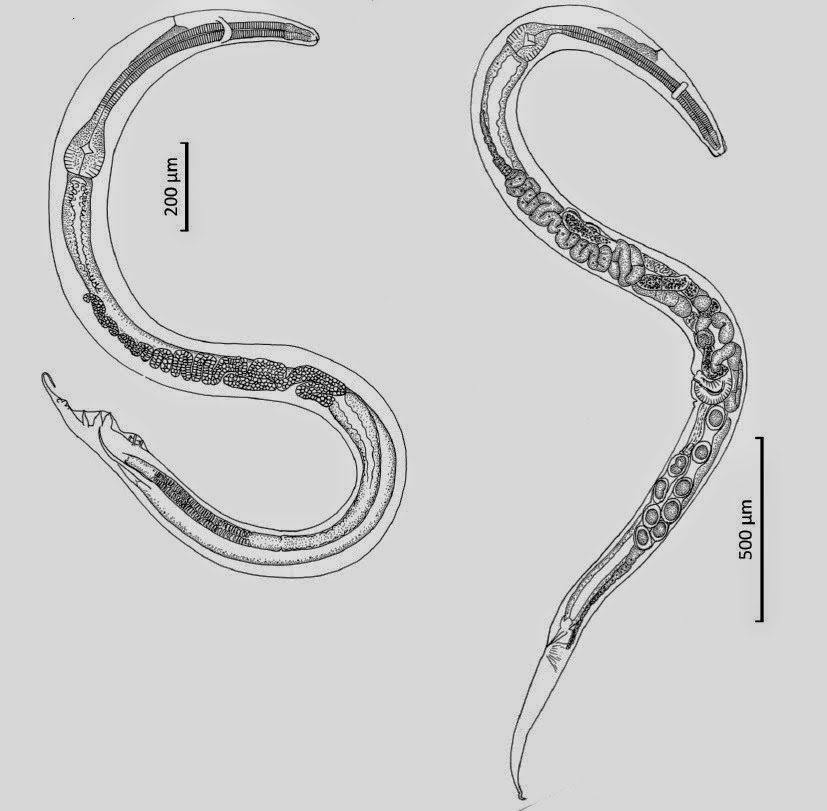Pinworms, Oxyuridae, are parasitic Nematodes infecting the digestive
tracts of Mammals. They have short life cycles, typically undergoing several
generations in a year, with eggs being released in the host’s faecal matter to
infect new hosts. Some species of Pinworm appear to be quite cosmopolitan,
infecting a range of hosts, but most species have a close relationship with a
specific host species and rarely cross-infect other species.
In a paper published in the Raffles Bulletin of Zoology on 18
September 2014, Kartika Dewi of the Zoology Division at Museum Zoologicum Bogoriense, Hideo Hasegawa of the Department of Biology at OitaUniversity and Mitsuhiko Asakawa of the Department of Parasitology at
Rakuno Gakuen University describe two new species of Pinworms from Sulawesi
Soft-furred Rats, Eropeplus canus,
trapped at Lambanan in the South Sulawesi Administrative District. The Sulawesi
Soft-furred Rat is an indigenous species to Sulawesi (i.e. found nowhere else),
known only from a few mountainous localities (altitudes between 1800 and 2300 m) and considered to be Vulnerable
under the terms of the International Union for the Conservation of Nature’s Red
List of Threatened Species. Both of the new species are placed in the genus Syphacia, seven species of which have
previously been recorded from Indonesia; the cosmopolitan Syphaciamuris, which infects a variety of Rats (Rattus spp.), plus four species infecting
indigenous Rodents on Sulawesi and one species each infecting Rodents on
Halmahera and Papua.
The first new species is placed in a new subgenus, Rumbaisyphacia, which is a combination
of ‘rumbai’, an Indonesian word meaning ‘fringe’ and the name of the genus
(i.e. ‘fringed Syphacia’) and given
the specific name kumis, meaning
‘moustache’ in Indonesian; both names refer to a fringe of papillae around the
mouthparts. The species is described from twenty two specimens, eleven of each
species. The females are considerably larger than the males, at 3.21–4.12 mm as
opposed to 1.51–1.72 mm.
Syphacia (Rumbaisyphacia) kumis, from Eropeplus canus in south Sulawesi, Indonesia. (1) male, lateral view;
(2) cephalic end of male, apical view. Dewiet
al. (2014).
The second new species is also placed in a new subgenus, Segienamsyphacia, from ‘Segienam’, which
means ‘hexagonal’ in Indonesian, a reference to the mouthparts of the female,
and given the specific name yuniae in
honour of Yuni Apriyanti, who prepared the specimens for observation by SEM.
This species is also described from eleven male and eleven female specimens.
The females of this species are also bigger than the males (though not as much
so as in Syphacia (Rumbaisyphacia) kumis) at 2.34–2.56 mm in the females and 1.00–1.25 mm in the
males.
Syphacia (Segienamsyphacia) yuniae, from Eropeplus canus in south Sulawesi, Indonesia. (11) male, lateral
view; (12) cephalic end of male, apical view. (18)Female, lateral view; (19)
cephalic end of female, apical view. Dewi et
al. (2014).
Dual infections of Pinworms are rare in Rodents, with most species
having a single Pinworm parasite, and where more than one species is present
this is generally thought to be an exceptional situation in which unhealthy
animals have been opportunistically infected by non-specific parasites. However
all of the Sulawesi Soft-furred Rats inspected were suffering from infections
of both Pinworm species, and did not appear to be particularly unhealthy. Dewiet al. suggest that as additional
resource partition by the parasites, with the Pinworms probably infecting
different microhabitats of utilizing different nutrients.
SEM of mouth opening Syphacia (Rumbaisyphacia)
kumis showing setiferous apical margin
of pharynx. Dewi et al. (2014).
See also…
Parasitic Nematodes of the superfamily Heterakoidea are typified by
having three lips, an esophagus with a valved bulb, thick shelled eggs and a
pre-anal sucker on the males. They are typically parasites of the digestive
tracts of small vertebrates, which do not require an intermediate host (i.e.
the species only needs to infect one species of hosts, rather than infecting
different...
The science of palaeoparasitology involves the study of parasite
remains from palaeontological and archaeological sites. This rarely involves
the recovery...
Nematodes are probably the most numerous and specious group of animals
on Earth, though relatively few species have actually been described.
The title of...
Follow Sciency Thoughts on Facebook.






